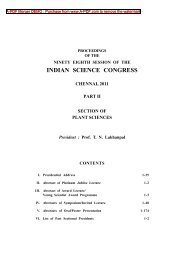Addressing Emissions From Coal Use in Power Generation ...
Addressing Emissions From Coal Use in Power Generation ...
Addressing Emissions From Coal Use in Power Generation ...
Create successful ePaper yourself
Turn your PDF publications into a flip-book with our unique Google optimized e-Paper software.
Congressional Policy Brief 7<br />
Obstacles to CCS Deployment<br />
Firms have proven reluctant to <strong>in</strong>vest <strong>in</strong> CCS<br />
given the absence of any f<strong>in</strong>ancial cost associated<br />
with GHG emissions, uncerta<strong>in</strong>ty over the future<br />
regulations govern<strong>in</strong>g coal-fueled power plants<br />
and CO 2<br />
storage, and the need<br />
for additional research,<br />
development and<br />
demonstration (RD&D) for<br />
CCS. Add<strong>in</strong>g CCS technology<br />
to an exist<strong>in</strong>g or planned<br />
coal-fueled power plant requires<br />
additional <strong>in</strong>vestment which<br />
firms will not undertake <strong>in</strong> the<br />
absence of government technology standards or a<br />
policy that assigns a cost to GHG emissions.<br />
A cap-and-trade program, such as that proposed<br />
<strong>in</strong> S. 2191 (discussed above) or its successor, the<br />
Boxer-Lieberman-Warner Climate Security Act<br />
of 2008 (S. 3036) effectively puts a price on<br />
GHG emissions. Without a cap-and-trade or<br />
other regulatory policy <strong>in</strong> place, firms do not<br />
know what, if any, future costs they will face for<br />
GHG emissions. This uncerta<strong>in</strong>ty h<strong>in</strong>ders<br />
<strong>in</strong>vestments <strong>in</strong> CCS.<br />
Firms face challenges <strong>in</strong> f<strong>in</strong>anc<strong>in</strong>g CCS projects<br />
both <strong>in</strong> states with traditional cost-of-service<br />
electricity regulation and <strong>in</strong> states with<br />
restructured electricity markets. Given the large<br />
<strong>in</strong>cremental costs of CCS and the obligation<br />
of public utility commissions (PUCs) to protect<br />
ratepayers from excessive costs, a utility <strong>in</strong> a<br />
traditionally regulated state that sought to build a<br />
power plant with CCS would likely have difficulty<br />
justify<strong>in</strong>g it as a prudent <strong>in</strong>vestment given the<br />
absence of a regulatory policy requirement or<br />
Nearly all <strong>in</strong>dividual<br />
components of CCS<br />
technologies are currently<br />
employed on an<br />
<strong>in</strong>dustrial scale.<br />
a cost placed on GHG emissions and the risk<br />
associated with new technologies that have not<br />
been extensively deployed at a commercial scale.<br />
For the same reasons, <strong>in</strong> states with restructured<br />
electricity markets, capital markets may be<br />
reluctant to provide f<strong>in</strong>anc<strong>in</strong>g<br />
for CCS projects to power<br />
producers. Moreover, s<strong>in</strong>ce<br />
society at large will benefit<br />
from the valuable <strong>in</strong>formation,<br />
experience, and cost<br />
reductions that <strong>in</strong>itial<br />
CCS projects will generate<br />
(see discussion below), utility<br />
regulators may be reluctant to impose the<br />
<strong>in</strong>cremental cost of CCS on the ratepayers<br />
<strong>in</strong> a s<strong>in</strong>gle state. 33<br />
Firms also face uncerta<strong>in</strong>ty regard<strong>in</strong>g regulations<br />
related to CCS. The federal and state governments<br />
have not yet established the necessary regulations<br />
to govern CO 2<br />
transport and storage, such as site<br />
selection, operation, monitor<strong>in</strong>g, closure, longterm<br />
care, and liability for CO 2<br />
storage. Faced<br />
with uncerta<strong>in</strong>ty regard<strong>in</strong>g the regulatory<br />
framework and associated cost implications for<br />
CO 2<br />
storage, firms are even more reluctant to<br />
<strong>in</strong>vest <strong>in</strong> CCS at this time.<br />
There is also a need for additional CCS RD&D.<br />
Nearly all <strong>in</strong>dividual components of CCS<br />
technologies are currently employed on an<br />
<strong>in</strong>dustrial scale for purposes rang<strong>in</strong>g from fertilizer<br />
manufactur<strong>in</strong>g to EOR. 34 However, to date no<br />
commercial-scale coal-fueled power plant employs<br />
CCS as an <strong>in</strong>tegrated suite of technologies. 35<br />
There exists significant uncerta<strong>in</strong>ty regard<strong>in</strong>g the

















